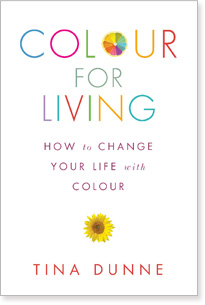 Your Health : The Glycaemic Index Your Health : The Glycaemic Index
Click on the links below for information on :
Fatigue ¦ Stress ¦ Cholesterol ¦ The Glycaemic Index
What is the Glycaemic Index?
The Glycaemic index (GI) is about the quality of the carbohydrates, not the quantity. It is a scientific test that measures how long your body takes to convert carbohydrates from the time that you put food into your mouth, to the time that the glucose is stored in your cells. Foods are ranked based on how they compare to a reference food- either glucose or white bread. Foods that slowly convert carbohydrates into glucose are called low GI Foods. Foods that quickly turn form carbohydrates to glucose are called high GI Foods. Food is evaluated according to the rate at which it is broken down and converted into glucose. The slower it is broken down the better, as it will help you to function more effectively. Therefore choose foods with GI rating less than 50.The concept was developed by Dr. David J Jenkins and colleagues in 1980–1981 at the University of Toronto, Canada.
The glycaemic index of a food is defined as the area under the two hour blood glucose response curve (AUC) following the ingestion of a fixed portion of carbohydrate (usually 50 g).The AUC of the test food is divided by the AUC of the standard (either glucose or white bread, giving two different definitions) and multiplied by 100.
The glycaemic index is only applied to foods with a reasonable carbohydrate content, as the test relies on subjects consuming enough of the test food to yield about 50 g of available carbohydrate. Many fruits and vegetables (excluding potatoes) contain very little carbohydrate per serving, and the average person is not likely to eat 50g of carbohydrate from these foods.
Please click on the link below for recipes on
Low Glycaemic Index Dining
GI values are commonly interpreted as follows:
Classification |
GI range |
Examples |
Low GI |
55 or less |
most fruitsand vegetables (except potatoes, watermelon), grainy breads, pasta, legumes/pulses, milk, products extremely low in carbohydrates (fish, eggs, meat, some cheeses, nuts, cooking oil), brown rice |
Medium GI |
56 - 69 |
whole wheat products, basmati rice, sweet potato, table sugar, most white rice (e.g. jasmine)
|
High GI |
70 and above |
corn flakes, rice krispies, baked potatoes, watermelon, croissants, white bread, straight glucose (100)
|
source: www.wikipedia.org/wiki/glycaemic_index
| Cereal Grains |
| Pearl barley |
Low |
25 |
| Rye |
Low |
34 |
| Wheat kernels |
Low |
41 |
| Rice, instant |
Low |
46 |
| Rice, parboiled |
Low |
48 |
| Barley, cracked |
Low |
50 |
| Rice, brown |
Medium |
55 |
| Rice, wild |
Medium |
57 |
| Rice, white |
Medium |
58 |
| Barley, flakes |
Medium |
66 |
| Taco Shell |
Medium |
68 |
| Millet |
High |
71 |
| copyright © 2003-2008 www.southbeach-diet-plan.com |
The measurement of the glycaemic index of a food is not related to portion size. It remains the same whether you eat 10 grams of it or 1000 grams. You can eat twice as many carbohydrates in a food that, for example, has a glycaemic index of 50 than one that has a glycaemic index of 100 and have the same blood glucose response.
For more information, see Wolever, Thomas M.S. et al. 'The Glycemic Index: Methodology and Clinical Implications'.
Professor Jennie Brand-Miller at the Human Nutrition Unit, Sydney University has been at the forefront of glycaemic index research for over a decade, and her research group has determined the GI values of more than 400 foods.
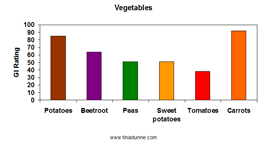 Pizza Pizza
Many people have noticed that pizza seems to keep their blood glucose level high longer than just about any other food. While the reason remains a mystery. Ahern et al. compared the effect on insulin-dependent patients of a pizza meal with a control meal that included high glycaemic index foods. They found that although the initial glucose increase was similar for the two meals, the GI continued to rise and was significantly increased from four to nine hours after the pizza meal compared with the control meal.
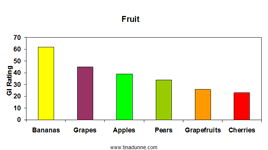 Rice and Potatoes Rice and Potatoes
Rice and potatoes are some of the foods most tested for their glycaemic indexes. They are important both because most of us tend to eat a lot of rice and potatoes and because they can have a high glycaemic index. Professor Brand-Miller reports the results of 49 studies of rice and 24 studies of potatoes. The results for rice ranged all the way from 54 to 132 and for potatoes from 67 to 158.
What could possibly cause such tremendous variation? According to Professor
Brand-Miller, for rice one of the most important considerations is the ratio of amylose to amylopectin. She says that "the only whole (intact) grain food with a high G.I. factor is low amylose rice.
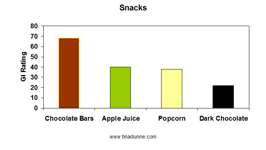 However, some varieties of rice (Basmati, a long grain fragrant rice, and Doongara, a new Australian variety of rice have intermediate G.I. factors because they have a higher amylose content than normal rice. Wallace Yokoyama, a research chemist working for the U.S. Department of Agriculture in Albany, California, says there are four types of rice:Long-grain, medium-grain, short-grain, and sweet rice. Sweet rice is also known as sticky or waxy rice. It is usually used in Asian restaurants. Sweet rice has no amylose, Yokoyama says. In other words, it is the rice that has the highest glycaemic index. The three other types of rice have lower glycaemic indexes. Of course, each of these three types of rice may be brown or white. Brown rice has a lower glycemic index than white rice, everything else being equal. Therefore brown long-grain rice—or if you can find it—brown Basmati rice—will probably have a lower glycaemic index. White Basmati rice had a glycaemic index of 83 in one study. Brown Basmati rice can be expected to have a somewhat lower index, but we don't know precisely what it is, because the studies haven't been done yet. In fact, Uncle Ben's Converted Rice is the lowest glycaemic rice you can get. This is white rice. Jennie Brand-Miller has indicated that this company may use a secret process. Among potatoes, new and some white potatoes have the lowest indexes. The reason that new potatoes have a lower GI is probably because most of the amylopectin is less branched—it is more like amylose at this immature stage. However, some varieties of rice (Basmati, a long grain fragrant rice, and Doongara, a new Australian variety of rice have intermediate G.I. factors because they have a higher amylose content than normal rice. Wallace Yokoyama, a research chemist working for the U.S. Department of Agriculture in Albany, California, says there are four types of rice:Long-grain, medium-grain, short-grain, and sweet rice. Sweet rice is also known as sticky or waxy rice. It is usually used in Asian restaurants. Sweet rice has no amylose, Yokoyama says. In other words, it is the rice that has the highest glycaemic index. The three other types of rice have lower glycaemic indexes. Of course, each of these three types of rice may be brown or white. Brown rice has a lower glycemic index than white rice, everything else being equal. Therefore brown long-grain rice—or if you can find it—brown Basmati rice—will probably have a lower glycaemic index. White Basmati rice had a glycaemic index of 83 in one study. Brown Basmati rice can be expected to have a somewhat lower index, but we don't know precisely what it is, because the studies haven't been done yet. In fact, Uncle Ben's Converted Rice is the lowest glycaemic rice you can get. This is white rice. Jennie Brand-Miller has indicated that this company may use a secret process. Among potatoes, new and some white potatoes have the lowest indexes. The reason that new potatoes have a lower GI is probably because most of the amylopectin is less branched—it is more like amylose at this immature stage.
Fructose and High Fructose Corn Syrup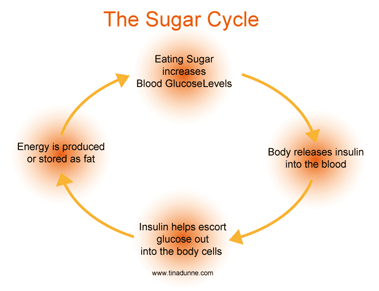
An addition to the published glycaemic indexes is high fructose corn syrup. Fructose is not the same as high fructose corn syrup, Professor Jennie Brand-Miller emphasizes the former is pure fructose; the latter [high fructose corn syrup] is a mixture of fructose and glucose. In high fructose corn syrups, the fructose content is about 50 percent. Thus the GI of high fructose corn syrups is about the same as sucrose, i.e. 60-65
(if glucose = 100)." When white bread = 100, the GI of high fructose corn syrups is 85-92.
Useful Websites
http://www.mendosa.com/freefoods.htm
http://www.mendosa.com/gilists.htm
http://en.wikipedia.org/wiki/Glycemic_index
http://www.nutramed.com/diabetes/glycemicindex.htm
http://www.diabetes.org/food-nutrition-lifestyle/nutrition/meal-planning
www.glycemicindex.com
www.the-gi-diet.org
www.indi.ie
www.eufic.org
www.tinadunne.com
http://www.southbeach-diet-plan.com
http://www.weightlossforall.com/glycemic-list-fruits-vegs.
http://www.dietitian.com/carbos.html
Useful Reference Books
Brand-Miller, Janette, et al. 'Rice: a High or Low Glycemic Index Food?'
The American Journal of Clinical Nutrition, VOL, 56, 1992, pp. 1034-1036
Low-Glycemic Index Diet Cookbook Brand – Miller, Jennie.Marlowe & Company
The GI Diet- Shopping and Eating out Pocket Guide.Virgin Books ISBN 0753510324
Getting the Best From the GI Diet.Rick Gallop ISBN 9780753513705
The Holford Low GI Diet.Piatkus ISBN 978 0749925437
|
